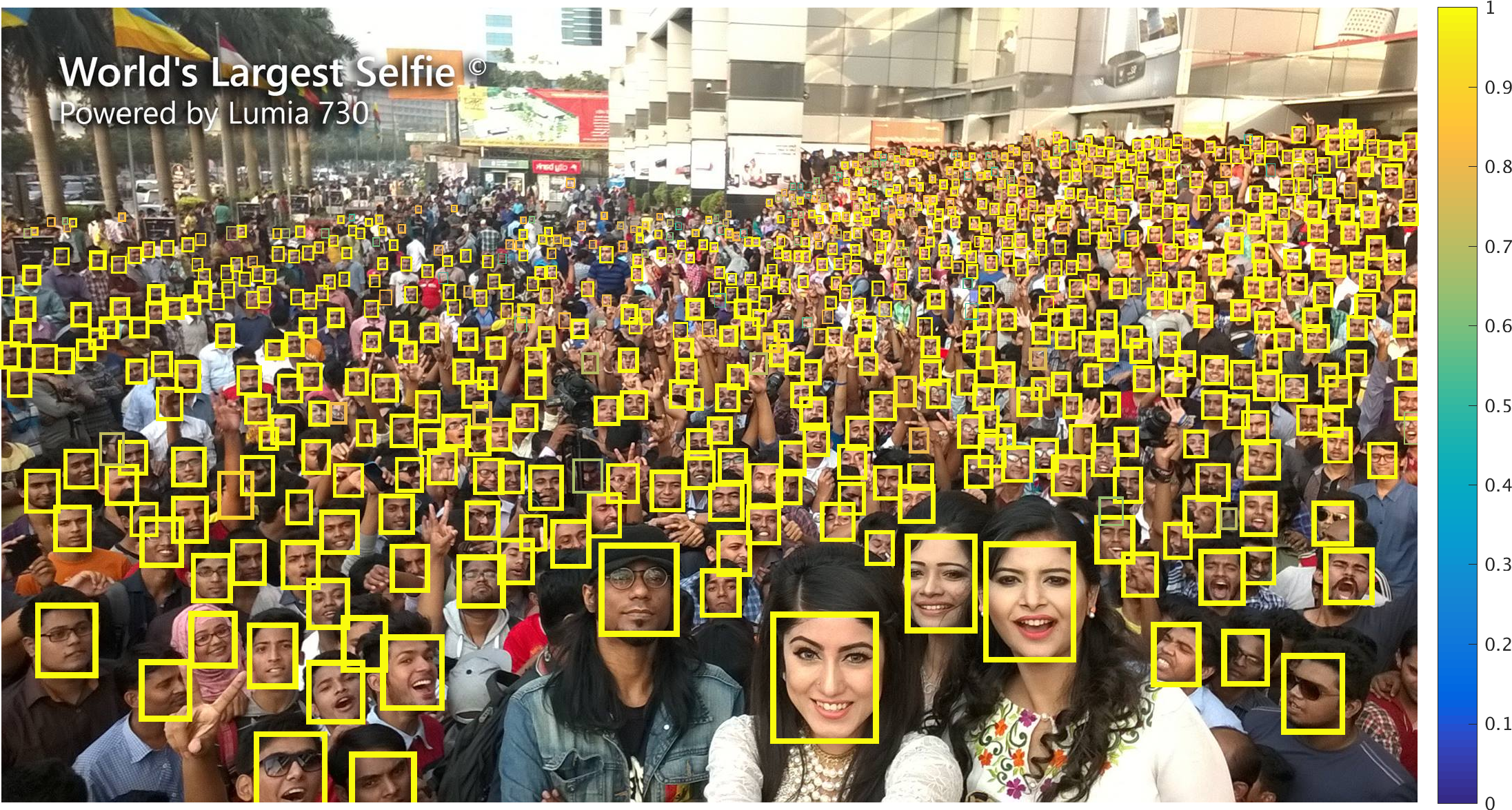Ecosyste.ms: Awesome
An open API service indexing awesome lists of open source software.
https://github.com/peiyunh/tiny
Tiny Face Detector, CVPR 2017
https://github.com/peiyunh/tiny
detection detector face-detection face-detector scale-invariance
Last synced: 3 days ago
JSON representation
Tiny Face Detector, CVPR 2017
- Host: GitHub
- URL: https://github.com/peiyunh/tiny
- Owner: peiyunh
- License: other
- Created: 2016-12-09T22:23:36.000Z (almost 8 years ago)
- Default Branch: master
- Last Pushed: 2020-03-21T02:04:30.000Z (over 4 years ago)
- Last Synced: 2024-09-25T22:06:23.865Z (8 days ago)
- Topics: detection, detector, face-detection, face-detector, scale-invariance
- Language: MATLAB
- Homepage: https://cs.cmu.edu/~peiyunh/tiny
- Size: 49.2 MB
- Stars: 1,133
- Watchers: 78
- Forks: 319
- Open Issues: 5
-
Metadata Files:
- Readme: README.md
- License: LICENSE
Awesome Lists containing this project
README

# Finding Tiny Faces
By Peiyun Hu and Deva Ramanan at Carnegie Mellon University.
## Introduction
We develop a face detector (Tiny Face Detector) that can find ~800 faces out of ~1000 reportedly present, by making use of novel characterization of scale, resolution, and context to find small objects. Can you confidently identify errors?
Tiny Face Detector was initially described in an [arXiv tech report](https://arxiv.org/abs/1612.04402).
In this repo, we provide a MATLAB implementation of Tiny face detector, including both training and testing code. A demo script is also provided.
### Citing us
If you find our work useful in your research, please consider citing:
```latex
@InProceedings{Hu_2017_CVPR,
author = {Hu, Peiyun and Ramanan, Deva},
title = {Finding Tiny Faces},
booktitle = {The IEEE Conference on Computer Vision and Pattern Recognition (CVPR)},
month = {July},
year = {2017}
}
```
## Installation
Clone the repo recursively so you have [my fork of MatConvNet](https://github.com/peiyunh/matconvnet/tree/9822ec97f35cf5a56ae22707cc1c04e0d738e7db).
```zsh
git clone --recursive [email protected]:peiyunh/tiny.git
```
Compile MatConvNet by running following commands in MATLAB (see [Installing - MatConvNet](http://www.vlfeat.org/matconvnet/install/) for more details):
```Matlab
>> cd matconvnet/;
>> addpath matlab/;
>> vl_compilenn('enableImreadJpeg', true, 'enableGpu', true, 'cudaRoot', [cuda_dir],...
'cudaMethod', 'nvcc', 'enableCudnn', true, 'cudnnRoot', [cudnn_dir]);
>> vl_testnn('gpu', true); % vl_testnn('gpu', false) for cpu-only
```
Compile our MEX function in MATLAB and test if it works as expected:
```Matlab
>> cd utils/;
>> compile_mex;
>> test_compute_dense_overlap;
```
Download [WIDER FACE](http://mmlab.ie.cuhk.edu.hk/projects/WIDERFace/) and unzip data and annotation files to `data/widerface` such that:
```zsh
$ ls data/widerface
wider_face_test.mat wider_face_train.mat wider_face_val.mat
WIDER_test/ WIDER_train/ WIDER_val/
```
## Demo
We provide a minimal demo `tiny_face_detector.m` that runs our detector on an single input image and output face detections:
```Matlab
function bboxes = tiny_face_detector(image_path, output_path, prob_thresh, nms_thresh, gpu_id)
```
Here is a command you can run to reproduce our detection results on the world's largest selfie:
```Matlab
>> bboxes = tiny_face_detector('data/demo/selfie.jpg', './selfie.png', 0.5, 0.1, 1)
```
The demo script will start by downloading an off-the-shelf ResNet101-based model, if it does not find one. Models based on other architecture are also available below:
- [ResNet101](https://drive.google.com/file/d/1YO8zTXGCACRZvHDxtW8dEZL7CE8HVFJ8/view?usp=sharing)
- [ResNet50](https://drive.google.com/file/d/1RFcSglvtasctXJQI1BS3laENXNvP8mwl/view?usp=sharing)
- [VGG16](https://drive.google.com/file/d/1cOm-AiZFulruQpb9gRmFlRhsdL9bXJZZ/view?usp=sharing)
## Training
To train a ResNet101-based Tiny Face Detector, run following command in MATLAB:
```Matlab
>> hr_res101('train'); % which calls cnn_widerface.m
```
After training, run the following command to test on the validation set:
```Matlab
>> hr_res101('test'); % which calls cnn_widerface_test_AB.m
```
Finally, run the following command to evaluate the trained models:
```Matlab
>> hr_res101('eval'); % which calls cnn_widerface_eval.m
```
Please refer to `scripts/hr_res101.m` for more details on how training/testing/evaluation is configured.
### Clustering
We derive canonical bounding box shapes by K-medoids clustering (`cluster_rects.m`). For reproducibility, we provide our clustering results in `data/widerface/RefBox_N25.mat`. We also provide the version after template resolution analysis in `data/widerface/RefBox_N25_scaled.mat` (Fig. 8 in our paper).
### Evaluation
We provide both our own version of evaluation script (`cnn_widerface_eval.m`) and official evaluation script (`eval_tools/`). Our implementation runs much faster and is easier to customize. However, our version produces slightly lower numbers comparing to the official one. We use our evaluation script only for prototyping. All numbers in the paper are based on the official evaluation script.
## FAQ
### How do I train it on my own datasets?
Training a `tiny-X-detector` on your own dataset takes just a little bit of coding and it is certainly doable. I would suggest start from the script named `cnn_setup_imdb.m`. The script produces a `imdb.mat` file which contains information about the path of images and the ground truth bounding boxes. Try modifying `cnn_setup_imdb.m` to make sure such information of your dataset goes into `imdb.mat`.
## Third-party re-implementations
- PyTorch version by Varun Agarwal (@varunagrawal) at https://github.com/varunagrawal/tiny-faces-pytorch